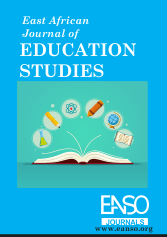Examining Secondary School Teaching Methods: Perspectives from the 2014 South Sudan National Curriculum Framework
Abstract
The global trend for educational reform is directed towards learner-centered pedagogy. Many Sub-Saharan countries have already resorted to this approach to teaching. South Sudan has taken this initiative by launching and implementing a competency-based curriculum from preschool through secondary level in 2018. The 2014 national curriculum framework philosophical strategy towards instruction is entrenched in a constructivist approach. The framework emphasizes learning to be extended beyond textbooks from teacher-directed lessons (teacher-centred) to learner’s active engagement. This inspired the investigators to conduct an in-depth examination of the nature of instructional practices existent in secondary schools. The study employed mixed method convergent parallel design in 15 secondary schools purposefully selected within Juba city. Questionnaires were self-administered to 225 teachers, interviews and Focus Group discussions (FGD) were designed and conducted on 4 officials in the Ministry of General Education and Instruction (MoGEI) in departments of curriculum and inspection,13 head teachers and 12 teachers of the sampled schools. Findings demonstrate the application of both teacher-centred and learner-centred methods, challenges obstructing teachers from applying the learner-centred mode of instruction, lack of feasibility studies conducted before the inception of this reform, and high awareness possessed by teachers on instructional methods to be utilized. The investigators recommended that both teachers and students should endeavour collaboratively to improve their comprehension of learner-centred practices and the government should consistently support schools, evaluate field practices to minimize the policy practice gap then grant schools the opportunity to print authorized textbooks for teaching the South Sudan syllabus
Downloads
References
Akpan, V. I., Igwe, U., Mpamah, I., & Okoro, C. (2020). Social constructivism: implications on teaching and learning. British Journal of Education, 8(8), 49- 56. https://www.eajournals.org/wp-content/uploads/Social-Constructivism.pdf
Amos, A. A., Folasayo, O. A., & Oluwatoyin, A. E. (2015). Instructional strategies for effective teaching and learning in Nigeria secondary schools. First Asia Pacific Conference on Advanced Research (APCAR), https://apiar.org.au/wp- content/uploads/2015/07/APCAR_BRR710_Paper.pdf
Ansari, M., Ilyas, R., & Shah, S. W. A. (2021). Exploring challenges in the implementation of Learner-centered Approach in Pakistani EFL Classrooms. https://iiste.org/Journals/index.php/JLLL/article/view/57298
Baran, M. L., & Jones, J. E. (2019). Applied social science approaches to mixed methods research. IGI Global. https://books.google.com › Reference › Research
Creswell, J. W. (2009). Research designs: Qualitative, quantitative, and mixed methods approaches. Callifornia: Sage. https://www.ucg.ac.me/skladiste/blog_609332/objava_105202/fajlovi/Creswell.pdf
Evertson, C. M., & Neal, K. W. (2006). Looking into Learning-Centered Classrooms: Implications for Classroom Management. Working Paper. National Education Association Research Department. https://files.eric.ed.gov/fulltext/ED495820.pdf
Fah, L. Y., & Hoon, K. C. (2021). Quantitative Approaches in Educational Research. Universiti Malaysia Sabah Press.
Folashade, A. J. (2023). Exploring the Challenges and Possibilities of Using Learner-Centered Approach to Teach in Nigeria Public Secondary Schools. African Perspectives of Research in Teaching and Learning, 7(2), 213-232. https://books.google.com › Education › Research
Francis, O. R. (2008). Early childhood education curriculum and programs. In L. G. Thomas (Ed.), 21st century education: A reference handbook (Vol. 1, pp. 388 – 394). SAGE.
https://books.google.com › ... › Developmental › Child
Gingell, J., & Winch, C. (2008). Philosophy of education: The key concepts. Routledge. https://api.pageplace.de/preview/DT0400.9781134109661_A25025848/preview-9781134109661_A25025848.pdf
Guest, G., & Fleming, P. (2015). Mixed methods research. Public health research methods, 5, 581- 614. DOI: https://doi.org/10.4135/9781483398839.n19
Holcomb, Z. (2016). Fundamentals of descriptive statistics. Routledge. https://api.pageplace.de/preview/DT0400.9781351970334_A27750925/preview-9781351970334_A27750925.pdf
Johnson, B., & Christensen, L. (2014). Educational research (quantitative, qualitative, and mixed approaches, (Çev. Ed. SB Demir). Ankara: Eğiten Kitap. https://www.researchgate.net/publication/264274753_Educational_Research_Quantitative_Qualitative_and_Mixed_Approaches_Fifth_EditionJohnson, R. A., & Bhattacharyya, G. K. (2019). Statistics: principles and methods. John Wiley & Sons.https://books.google.co.ug/books/about/Statistics.html?id=0k6MDwAAQBAJ&redir_esc=y
Jony, M. (2016). Student-centred Instruction for Interactive and Effective Teaching Learning: Perceptions of Teachers in Bangladesh. Online Submission, 3(3), 172-178. https://files.eric.ed.gov › fulltext
Lincoln, Y. S. (1985). Naturalistic inquiry (Vol. 75). sage. https://books.google.com › ... › General
Mamba, D., & Putsoa, B. (2018). Secondary school science teachers’ knowledge and implementation of effective teaching strategies in high-performing schools in Swaziland. African Journal of Research in Mathematics, Science and Technology Education, 22(1), 14-26. https://doi.org/10.1080/18117295.2017.1386346
MoEST. (2015). South Sudan Education Statistics for Central Equatoria. Data and Statistics unit. https://mogei.gov.ss › assets › SSEMIS_2015_CEQ
MoGEI. (2021). National education census report. https://mogei.gov. ss › documents › resources › 20...
Noddings, N. (2016). Philosophy of Education (4th ed.). https://api.pageplace.de › preview › preview-9780...
Nsengimana, T., Habimana, S., & Mutarutinya, V. (2017). Mathematics and science teachers’ understanding and practices of learner-centred education in nine secondary schools from three districts in Rwanda. Rwandan Journal of Education, 4(1), 55- 68. : http://www.ce.ur.ac.rw/
Onajite, G. (2022). Teaching Strategies Employed By Teachers for Improving Students’ Learning in Business Education in Secondary Schools in Delta State. British Journal of Education, 10(3), 85- 100. https://doi.org/10.37745/bje.2013/vol10no3pp.85-100
Ray, M., Sharma, H., & Singh, U. (1987). Statistical methods. Ram Prasad Publications (RPH). https://books.google.co.ug/books/about/STATISTICAL_METHODS.html?id=niMqEAAAQBAJ&redir_esc=y
Salema, V. (2015). Assessment of the attitude of teachers and students towards learner-centred pedagogy in secondary schools in Kilimanjaro region. Educational Research, 6(2), 31-38. DOI: http:/dx.doi.org/10.14303/er.2015.11
Seier, E. (1998). A family of skewness and kurtosis measures. University of Wyoming. search.proquest.com
Shah, D., & Kumar, R. (2020). Similarities and differences between LCT and TCT. International Journal of Creative Research Thoughts (IJCRT), 8(7), 5694-5720. http://www.ijcrt.org/papers/IJCRT2007638, 2020
Toma, J. D. (2011). Approaching rigor in applied qualitative. The SAGE handbook for research in education: Pursuing ideas as the keystone of exemplary inquiry, 263-281. https://doi.org/10.4135/9781483351377.n17
Vass, E., & Littleton, K. (2010). Peer collaboration and learning in the classroom. International handbook of psychology in education, 105-135. https://books.google.com › ... › Educational Psychology
Vavrus, F., Thomas, M., & Bartlett, L. (2011). Ensuring quality by attending to inquiry: Learner-centered pedagogy in sub-Saharan Africa. UNESCO-IICBA Addis Ababa, Éthiopie. https://unesdoc.unesco.org/ark:/48223/pf0000216063
Westwood, P. S., & Westwood, P. (2008). What teachers need to know about teaching methods. Aust Council for Ed Research. https://books.google.com › ... › Levels › Elementary
Copyright (c) 2025 Rose Hezekiah Jonathan Kilonga, Imelda Kemeza, PhD, Alice Mwesgwa, PhD

This work is licensed under a Creative Commons Attribution 4.0 International License.




























